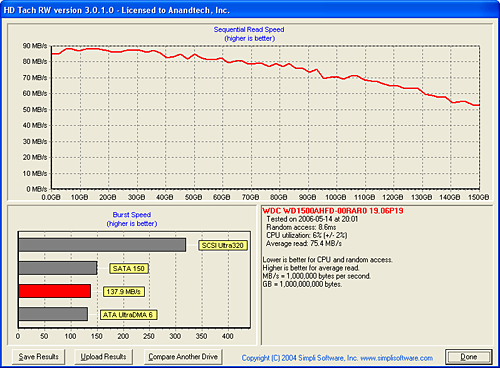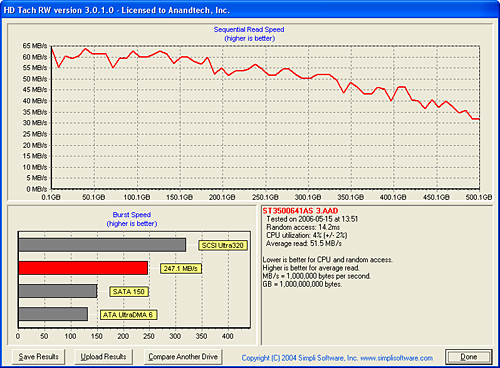Seagate Barracuda 7200.10 750GB: Size Does Matter
by Gary Key on May 18, 2006 9:00 AM EST- Posted in
- Storage
Features and HD Tach Test
| Drive Specifications | ||||
| Seagate Barracuda 7200.10 ST3750640AS |
Western Digital Raptor WD1500ADFD |
Western Digital RE2 WD5000YS |
Seagate Barracuda 7200.9 ST3500641AS |
|
| Manufacturer's Reported Capacity | 750GB | 150GB | 500GB | 500GB |
| Operating System Reported Capacity | 698.6GB | 139.7GB | 465.8GB | 465.8GB |
| Interface | SATA 300MB/s | SATA 150MB/s | SATA 300MB/s | SATA 300MB/s |
| Rotational Speed | 7200 RPM | 10000 RPM | 7200 RPM | 7200 RPM |
| Cache Size | 16 MB | 16 MB | 16 MB | 16 MB |
| Average Latency | 4.16 ms (nominal) | 2.99 ms (nominal) | 4.20 ms (nominal) | 4.16 ms (nominal) |
| Read Seek Time | 11 ms | 4.5 ms | 8.7 ms | 11 ms |
| Number of Heads | 8 | 4 | 8 | 8 |
| Number of Platters | 4 | 2 | 4 | 4 |
| Power Draw Idle / Load | 9.3W /12.6W | 9.2W / 10.0W | 8.9W / 10.8W | 7.4W / 13W |
| Command Queuing | Native Command Queuing | Native Command Queuing | Native Command Queuing | Native Command Queuing |
| Warranty | 5 Years | 5 Years | 5 Years | 5 Years |
The Seagate 7200.10 750GB drive we are reviewing today will be compared against two of the leading 500GB drives from Seagate and Western Digital along with the drive that has redefined performance in the Serial ATA market, the Western Digital WD1500 Raptor. While our Seagate 750GB drive is not in the same market sector as the Raptor, we thought it would be interesting to see how the two drives at the top of their respective classes perform against each other in our testing.
We are providing RAID 0 results for the Seagate 7200.10 for comparative results to the single drive. Seagate has recently released updated firmware for the 500GB 7200.9 that improves RAID performance; unfortunately we were unable to complete our testing with the new firmware before publication. Our RAID results for the WD1500 series will be published in our next storage article. The Western Digital 500GB drive is actually from the RE2 family and its design aspects are based upon the Raptor family. We will be having a 500GB roundup in the near future and will include the updated Hitachi Deskstar, Maxtor DiamondMax 11, Western Digital WD5000KS, and Seagate's own 7200.10 unit in our test results.
All of our drives are tested with Native Command Queuing (NCQ) enabled if the drive supports this technology. The reason for this is that a majority of users will not take the time to toggle NCQ on or off in the drivers so our test results will reflect this pattern. Native Command Queuing performance in single user applications has generally extracted a minor performance penalty when left enabled, with scores generally being 2%~4% lower in the current generation of drives. We noticed a 1% to 3% performance drop with the Seagate 7200.10 in our IPEAK benchmarks but nothing that would be noticed in actual application usage. Our recommendation at this time is to disable NCQ in single user environments to maximize the performance of the drive.
In the case of SATA 1.5Gbps/3Gbps operation we will remove the drive jumpers to enable this function if the drive supports it. Unless your core logic chipset and drivers support SATA 3Gbps operation, do not remove the drive jumper as this will generally result in a non-boot situation. The WD1500 Raptor does not support SATA 3Gbps operation and will operate at SATA 1.5Gbps. We did not notice a performance delta in the 7200rpm drives when enabling 3Gbps operation except in our synthetic benchmarks that measure and report burst speeds.
HD Tach




We find HD Tach to be useful for generating random access and average transfer rate results in a very consistent manner. Although the burst rates and CPU utilization rate numbers are somewhat interesting, they tend to be useless in actual application performance comparisons. In real world terms, CPU utilization rates in any DMA based storage system will typically be under 1% in all instances.
The Raptor has the highest average read rate of 75.4 MB/s with the Seagate 750GB drive following fairly closely with 66.9 MB/s, the Western Digital 500GB drive at 62.4 MB/s, and falling way behind at 51.5 MB/s is the Seagate 500GB drive. The 7200.10 has improved upon the 7200.9 series in this test by 29%.
The sequential read speed at the 500GB level for the 7200.10 is averaging 70 MB/s while the 7200.9 finishes at 31 MB/s. The Seagate 7200.10 and WD 500GB drives score about 40 MB/s at the end of the disk. In contrast, the WD Raptor finishes with a 52 MB/s result that is about 30% greater than the 7200 RPM drives. However, if you look at the read performance for the first 150GB on the 7200 RPM drives, all three manage higher minimum transfer rates than the Raptor.
The random access time benchmark favors the 10,000 RPM spindle speed of the Raptor, which generates a result of 8.6ms. The 7200 RPM drives results are all close together with the nod going to the WD 500GB drive at 13.4ms and the Seagate 750GB/500GB drives finish at 14.0ms and 14.2ms respectively. The average rotational latency at 10,000 RPM is 3ms while the average rotational latency at 7200 RPM is 4.17ms; what this means is that the head seek speed on the Raptor is significantly faster (~5.6ms) than the other drives (9.2-10.0ms). Although the two Seagate drives have excellent burst rates, we will soon see these results do not directly translate into class leading performance.










44 Comments
View All Comments
Gary Key - Thursday, May 18, 2006 - link
Seagates claims are correct from an objecitve measurement, subjectively the drive was louder in our testing at full load with either read or write seeks. I added the subjective statement in this paragraph to convey what I was explaining further in the article. Thanks!! :)Questar - Thursday, May 18, 2006 - link
Gary, I hate to nick-pick, but even the revised version doesn't read well. You start off with Seagate's claim that the .10 is quieter than the .9, you say you found something different, and then talk about the .10 compared to the other drives.You need to say the drive is subjectivly louder than the .9 (if it was).
Gary Key - Thursday, May 18, 2006 - link
Sorry about that, I had the WD 500GB statement in the sentence and not the Seagate 500GB, that was confusing, read it so many times that I missed it. It should read better now. :)
Zoomer - Friday, May 26, 2006 - link
Why don't you invite more people down to down some blind comparative tests?That would sort out some subjectivity. :)
ROcHE - Thursday, May 18, 2006 - link
Will you guys review more standard sizes? Like 320GB or so.I have seen the 750GB model reviewed only so far.
Gary Key - Thursday, May 18, 2006 - link
We will in June, Seagate will be shipping press samples out later this month. I want to see the 200GB~320GB drive range just as much as everyone else. ;-)
ROcHE - Thursday, May 18, 2006 - link
It's already up for sale. ???Buy one and be the first to review :)
Gary Key - Thursday, May 18, 2006 - link
I already bought the the additional 750GB, WD1500, and WD5000YS for RAID results. I do not know how much more the wife will let me spend this month. ;-) Anyway, Seagate is getting ready to ship two of the 320s out to us. Hopefully, I can get the review in before Computex. I am pretty much convinced this is the drive that will define the sweet spot in the market for performance, capacity, and price.
Zoomer - Friday, May 26, 2006 - link
From the spec sheet, the 400GB one seems promising to be a contender. It has a higher head to platter ratio. :)ROcHE - Friday, May 19, 2006 - link
Can't wait to see the results.